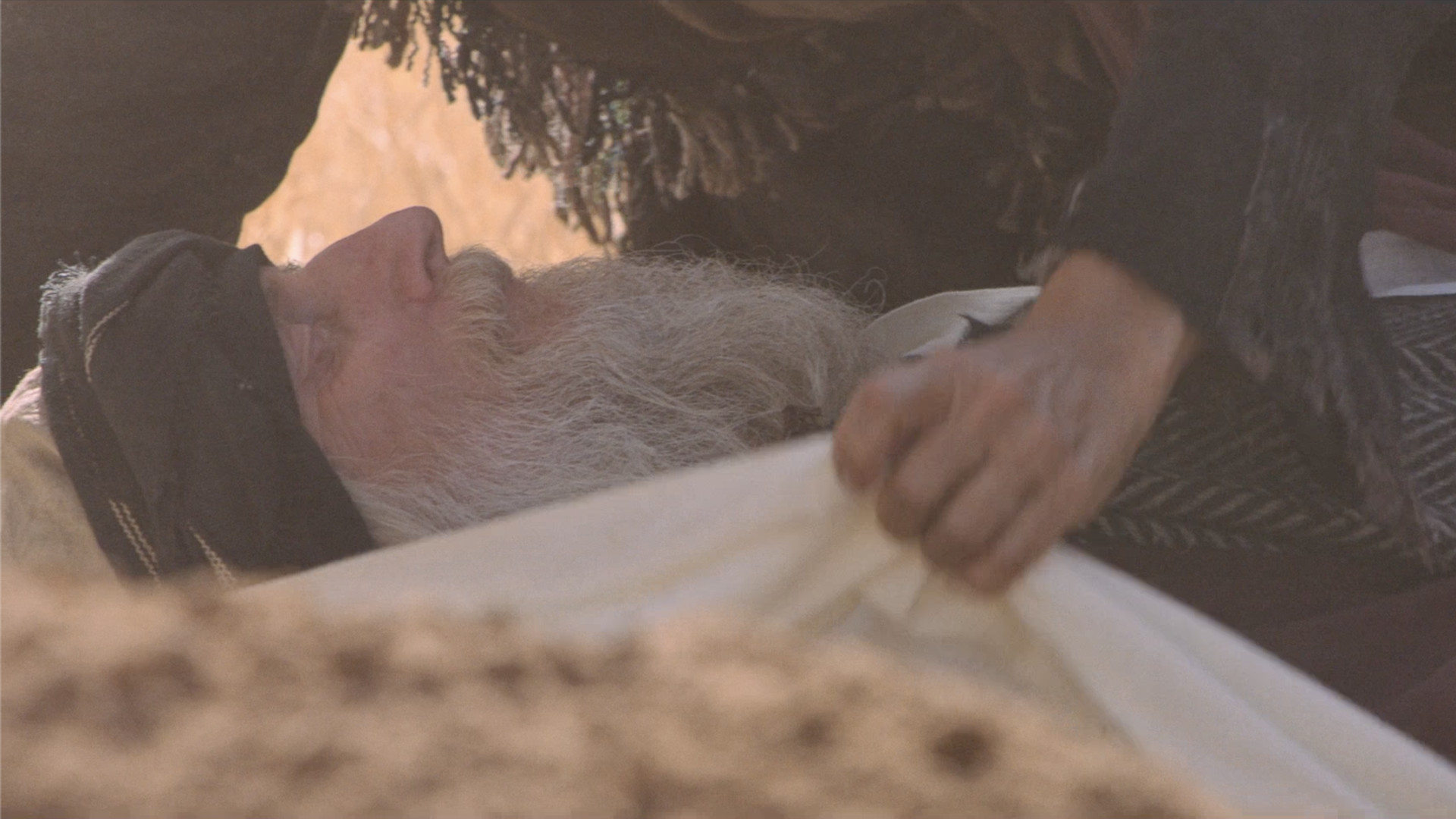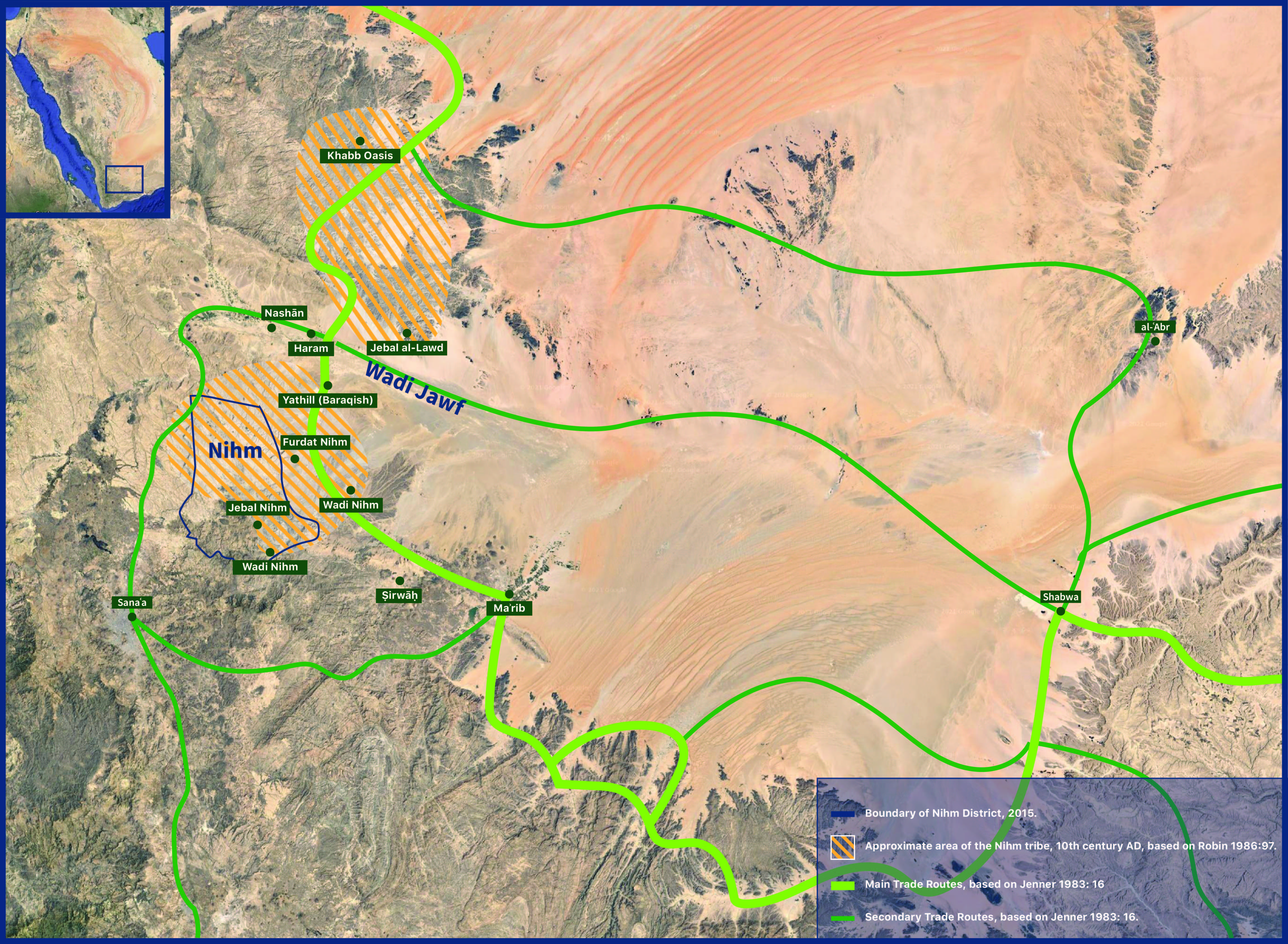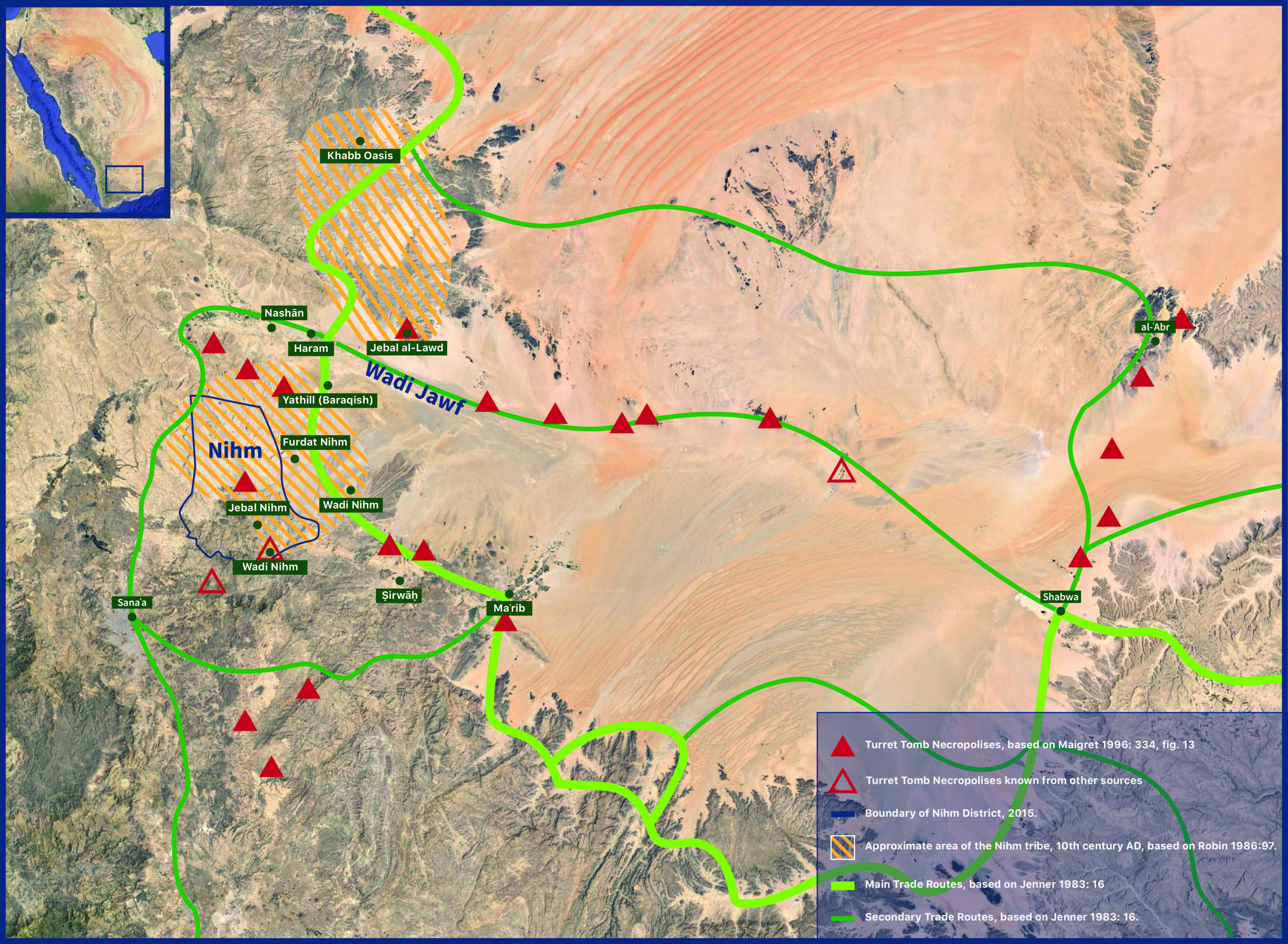
The Know
Latter-day Saint scholars have long recognized a likely correlation between “the place which was called Nahom,” where Lehi’s family buried their deceased traveling companion and beloved father-in-law, Ishmael, and the tribal and territorial name Nihm (sometimes spelled Naham, Nahm, Nehem, Nehhm, or another similar variant) in Yemen (1 Nephi 16:34).1 Inscriptions referring to individuals as nhmyn, usually translated as “Nihmite” (or sometimes “Nahmite” or “Nahamite”), provide evidence that this tribal group existed in the region during Lehi’s day.2
Some have wondered whether this evidence for people known as Nihmites can support the Book of Mormon’s reference to a place called Nahom. Recent research illustrates that in northern Yemen, toponyms are strongly linked to the tribal groups that live there, and this connection can be traced back to antiquity.3 According to Alessandra Avanzini, in the ancient South Arabian inscriptions, a tribal name indicated a “relationship with the tribal group and its territory.”4 Hence, scholars have variously identified nhmyn as both the “well-known tribal name NHM”5 and also as a term identifying someone “from the Nihm region, west of Marib.”6 In light of this close connection to tribes and their territories in Yemen, “there is little difficulty in linking a tribe in ancient inscriptions with what is called a ‘place’ in the Book of Mormon.”7
To better understand this potential link, recent research has also taken a closer look at the borders of the Nihm tribe in antiquity. In modern times, the district of Nihm (named after the tribe) is located northeast of Sanaʿa, to the south of the large valley called Wadi Jawf.8 Early Islamic sources, however, indicate that the Nihm tribe occupied both a similar territory south of the Jawf and a large region to the north of the Jawf as well (see map 1).9 While the exact borders of the tribal region in pre-Islamic times cannot be established with certainty, various references to the NHM name in ancient inscriptions suggest the tribe lived somewhere within this same area around the Jawf in antiquity.10

This has interesting implications when considered in light of the turn eastward Lehi’s family made after Nahom (1 Nephi 17:1). As various Book of Mormon researchers have noted, the modern location of Nihm is close to where ancient trails turned east, and located “nearly eastward” from the Wadi Jawf are the only known candidates for Bountiful.11 When the earlier borders of Nihm are taken into account, the tribal boundaries are even closer to where trails branch out eastward. In fact, three known trails cut east to west across Yemen in antiquity, and all three are in close proximity to the borders of Nihm documented by medieval Islamic geographers (see map 2).12

Extensive burial grounds have also been discovered in this same area, some found directly within territory historically associated with the Nihm tribe, where Ishmael could have been potentially buried.13 In fact, a burial stone dated to around the sixth century BC inscribed with the name YS1MʿʾL—the South Arabian form of the name Ishmael—was found somewhere within the Wadi Jawf.14 Whether or not this is the gravestone of the Book of Mormon Ishmael cannot be proven, but it confirms that “there was an Ishmael, buried near the Nihm tribal region, around the 6th century BC.”15
Additionally, there is a correlation between the distribution of burial grounds and the eastward trails (see map 3).16 According to Jean-François Breton, “A map of these [burial] sites shows how they run along the principal routes eastward from ʿIrma to Shabwa to Barâqish to upper Jawf. … There is a clear connection between the geographical distribution of these burial sites and the caravans that followed these routes.”17

Based on all these details, there appears to be a close relationship between eastward trailheads, burial of the dead, and the earliest known borders of Nihm. Similarly, in the Book of Mormon, the location of Nahom is connected to burial of the dead and eastward travel (1 Nephi 16:34–17:1). This threefold convergence of details makes it highly likely that Ishmael was buried somewhere within the Nihm tribal region of northern Yemen.18 A detailed analysis of all the evidence convinced one recent researcher that “the convergent relationship between Nahom and Nihm looks even tighter, more complex, and more strongly interlocking than previously suspected.”19
The Why
Nahom is the only place-name given in 1 Nephi that does not appear to be a name used exclusively by Lehi and his family.20 This specificity has allowed scholars to identify the likely location of Ishmael’s burial roughly 2,600 years ago. Given the uniqueness of this detail in Nephi’s record, it is worth considering why Nephi would provide an identifiable toponym here—and nowhere else—along his journey. One possible reason may be related to the importance of remembering the dead in antiquity.
For Lehi, his family, and most especially the children of Ishmael, the passing of Ishmael was a harrowing tragedy. Coming on the heels of great “afflictions in the wilderness,” such as “hunger, thirst, and fatigue,” Ishmael’s daughters “did mourn exceedingly, because of the loss of their father.” They lamented that they had been “brought … out of the land of Jerusalem” and “wandered much in the wilderness” (1 Nephi 16:35).
These complaints are best understood in light of Israelite beliefs about the proper burial of the dead, which ideally took place in the land of Israel near the burial sites of one’s ancestors.21 The biblical patriarchs Jacob and Joseph insisted that their remains be returned to the land of Israel when they passed away.22 This impulse was so strong that later generations of Jews in Yemen—the very area Lehi’s family was forced to bury Ishmael—actually “made great efforts to return to Judaea when burying their dead, sometimes embarking on a journey across the deserts of Arabia” to do so.23 Burial in their homeland near their ancestors best ensured they would be remembered, visited, and cared for by their kin.24
Not only could Ishmael not be returned to the land of Jerusalem for burial but the family would soon have to leave his grave behind, never able to return and commemorate their deceased patriarch. By recording the proper name of the place where Ishmael was buried, Nephi could ensure that Ishmael was remembered and honored by future generations despite these less-than-ideal circumstances. Indeed, 2,600 years later, inscriptions recording the names Nahom (NHM) and Ishmael (YS1MʿʾL) in South Arabia have ensured that Ishmael’s burial place is one of the most talked about and remembered places in the Book of Mormon record.25
Furthermore, the name Nahom itself may have been significant to Nephi and his family. In the South Arabian language, Nihm most likely referred to stone masonry, but to a Hebrew like Nephi, the roots nḥm and nhm carried meanings associated with comfort, consolation, and mourning for the dead.26 Jeremiah 16:5–9, for example, describes people who grieve for their loved ones at the “house of mourning” through a ritual feast meant to give comfort (nḥm) and consolation (tnḥmṯ) to the bereaved.27 Their general lack of food and water meant Lehi’s and Ishmael’s families probably could not gain comfort through food and drink, but the very name Nahom itself may have helped them seek and obtain the consolation they needed during this difficult time.28 As S. Kent Brown observed:
Even though the meaning was quite different in Old South Arabian—it referred to masonry dressed by chipping—the meaning in Hebrew may connect with the consolation that members of the party sought at Nahom after they buried Ishmael, father of one of the two families in the party. … On this basis, it is reasonable to presume that the name Nahom was also significant to them, perhaps reminding them of God’s comfort.29
The providential appearance of a name so rich in meaning for them at just the time when they were in need of divine comfort and consolation surely brought solace to their souls amid their grieving and bereavement.
Further Reading
Neal Rappleye, “The Nahom Convergence Reexamined: The Eastward Trail, Burial of the Dead, and the Ancient Borders of Nihm,” Interpreter: A Journal of Latter-day Saint Faith and Scholarship 60 (2024): 1–86.
S. Kent Brown, “The Discovery of Nahom,” in Be It Known: Book of Mormon Witnesses for Today’s Latter-day Saints (American Fork, UT: Covenant Communications, 2023), 47–50.
Neal Rappleye, “The Place—or the Tribe—Called Nahom? NHM as Both a Tribal and Geographic Name in Modern and Ancient Yemen,” BYU Studies 62, no. 2 (2023): 49–72.
Evidence Central, “Book of Mormon Evidence: Wordplay on Nahom,” Evidence #174 (March 30, 2021).
Neal Rappleye, “An Ishmael Buried Near Nahom,” Interpreter: A Journal of Latter-day Saint Faith and Scholarship 60 (2021): 33–48.
- 1. Book of Mormon Central, “Who Called Ishmael's Burial Place Nahom? (1 Nephi 16:34),” KnoWhy 19 (January 26, 2016).
- 2. Warren P. Aston, “Newly Found Altars from Nahom,” Journal of Book of Mormon Studies 10, no. 2 (2001): 56–61; Neal Rappleye, “Ishmael and Nahom in Ancient Inscriptions,” (paper presented at the 2022 FAIR Conference, Provo, UT, August 3, 2022). An expanded version of this paper is currently being prepared for publication. For translations of the term spelled either “Nahmite” or “Nahamite”—both close to the Book of Mormon spelling—see Mayer Lambert, “Les Inscriptions Yéménites du Musée de Bombay,” Revue d’Assyriologie et d’archéologie orientale 20 (1923): 80–81; Gonzague Ryckmans, “Inscriptions sud-arabes. Septième série,” Le Muséon: Revue D’études Orientales 55 (1942): 125–127; Albert Jamme, “Un désastre nabatéen devant Nagran,” Cahiers de Byrsa 6 (1956): 166; Albert Jamme, Miscellanées d’ancient arabe IX (Washington, DC: self-pub., 1979), 87. See also Albert van den Branden, Les Textes Thamoudéens de Philby, 2 vols. (Louvain, BE: Institut Orientaliste and Publications Universitaires, 1956), 1:52, where it is spelled “Nahimite.”
- 3. See Neal Rappleye, “The Place—or the Tribe—Called Nahom? NHM as Both a Tribal and Geographic Name in Modern and Ancient Yemen,” BYU Studies 62, no. 2 (2023): 49–72.
- 4. Alessandra Avanzini, By Land and by Sea: A History of South Arabia before Islam Recounted from Inscriptions (Rome, IT: L’Erma di Bretschneider, 2016), 59; emphasis added.
- 5. J. M. Solá Solé, Inschriften aus dem Gebiet Zwischen Mārib und dem Ğōf, Sammlung Eduard Glaser II (Vienna, AT: Der Öserreichischen Akadaemie der Wissenchaften, 1961), 40.
- 6. Burkhard Vogt, commentary on catalog no. 240, in Jemen: Kunst und Archäologie im Land der Königin von Saba’, ed. Wilfried Seipel (Wien: Kunsthistorisches Museum, 1998), 325, translated into English in Queen of Sheba: Treasures from Ancient Yemen, ed. John Simpson (London, UK: British Museum Press, 2002), 166. See Rappleye, “Place—or the Tribe—Called Nahom,” 66–71, for more discussion on how scholars have interpreted nhmyn.
- 7. Rappleye, “Place—or the Tribe—Called Nahom,” 72.
- 8. Rappleye, “Place—or the Tribe—Called Nahom,” 51, fig. 1; Neal Rappleye, “The Nahom Convergence Reexamined: The Eastward Trail, Burial of the Dead, and the Ancient Borders of Nihm,” Interpreter: A Journal of Latter-day Saint Faith and Scholarship 60 (2024): 24–26, map 5.
- 9. See Rappleye, “Nahom Convergence Reexamined,” 26–27; Rappleye, “Place—or the Tribe—Called Nahom,” 56–58; Christian Robin, “Nihm: Nubdha fī ʾl-jughrāfiyya al-taʾrīkhiyya wafqan li-muʿṭiyāt al-Hamdānī,” in Al-Hamdani: A Great Yemeni Scholar, Studies on the Occasion of His Millennial Anniversary, ed. Yusuf Mohammad Abdallah (Sanaʿa, YE: Sanaʿa University, 1986), 87–93, 97 (map).
- 10. Rappleye, “Nahom Convergence Reexamined,” 27–31; Hermann von Wissmann, Zur Geschichte und Landeskunde von Alt-Südarabien, Sammlung Eduard Glaser III (Vienna, AT: Der Öserreichischen Akadaemie der Wissenchaften, 1964), 84–85, map 2; 96–97, 294–295, map 17; 307–308.
- 11. S. Kent Brown, “New Light from Arabia on Lehi’s Trail,” in Echoes and Evidences of the Book of Mormon, ed. Donald W. Parry, Daniel C. Peterson, and John W. Welch (Provo, UT: FARMS, 2002), 89; S. Kent Brown, “New Light: Nahom and the ‘Eastward’ Turn,” Journal of Book of Mormon Studies 12, no. 1 (2003): 111–112, 120; Warren P. Aston, “The Arabian Bountiful Discovered? Evidence for Nephi’s Bountiful,” Journal of Book of Mormon Studies 7, no. 1 (1998): 4–11, 70; George D. Potter, “Khor Rori: A Maritime Resources-Based Candidate for Nephi’s Harbor,” Interpreter: A Journal of Latter-day Saint Faith and Scholarship 51 (2022): 253–294. The Dhofar region was established as the best candidate for Bountiful before any Latter-day Saints discovered the Nihm region. See Rappleye, “Nahom Convergence Reexamined,” 14.
- 12. See Richard LeBaron Bowen Jr., “Ancient Trade Routes in South Arabia,” in Archaeological Discoveries in South Arabia, ed. Richard LeBaron Bowen Jr. and Frank P. Albright (Baltimore, MD: Johns Hopkins Press, 1958), 35–42, fig. 33; Nigel Groom, Frankincense and Myrrh: A Study of the Arabian Incense Trade (Harlow, UK: Longman Group Limited; Beirut, Lebanon: Librairie de Liban, 1981), 167; Michael Jenner, Yemen Rediscovered (Essex, UK: Longman Group Limited, 1983), 16; Rappleye, “Nahom Convergence Reexamined,” 12–14, 31–32, 33, map 6.
- 13. See Rappleye, “Nahom Convergence Reexamined,”16–17.
- 14. Neal Rappleye, “An Ishmael Buried near Nahom,” Interpreter: A Journal of Latter-day Saint Faith and Scholarship 60 (2021): 33–48; Rappleye, “Nahom Convergence Reexamined,” 18–20; Mounir Arbach, Jérémie Schiettecette, and Ibrâhîm al-Hâdî, Collection of Funerary Stelae from the Jawf Valley: Sanʿâʾ National Museum, Part III (Sanaʿa, YE: Social Fund for Development and United Nations Educational, Scientific and Cultural Organization, 2008), 72, no. 105.
- 15. Rappleye, “Ishmael Buried near Nahom,” 38.
- 16. Rappleye, “Nahom Convergence Reexamined,” 18.
- 17. Jean-François Breton, Arabia Felix from the Time of the Queen of Sheba: Eighth Century BC to First Century AD, trans. Albert LaFarge (Notre Dame, IN: University of Norte Dame Press, 1999), 144.
- 18. See Rappleye, “Nahom Convergence Reexamined,” 31–41.
- 19. Rappleye, “Nahom Convergence Reexamined,” 38.
- 20. This has been noted by several scholars, going back to Hugh Nibley’s pioneering work on Lehi in the desert in the 1950s. See Rappleye, “Nahom Convergence Reexamined,” 1–2, 5–6, for discussion and quotes.
- 21. Rachel S. Hallote, Death, Burial, and Afterlife in the Biblical World (Chicago, IL: Ivan R. Dee, 2001), 46. See also Rappleye, “Nahom Convergence Reexamined,” 14–16.
- 22. Genesis 47:29–31; 49:29–33; 50:24–26.
- 23. Martin Gilbert, In Ishmael’s House: A History of Jews in Muslim Lands (New Haven, CT: Yale University Press, 2010), 6. See also Yosef Tobi, The Jews of Yemen: Studies in their History and Culture (Boston, MA: Brill, 1999), 3.
- 24. See Matthew J. Suriano, A History of Death in the Hebrew Bible (New York, NY: Oxford University Press, 2018).
- 25. Rappleye, “Ishmael and Nahom in Ancient Inscriptions.”
- 26. See Evidence Central, “Book of Mormon Evidence: Wordplay on Nahom,” Evidence #174 (March 30, 2021), online at evidencecentral.org.
- 27. See Philip J. King, Jeremiah: An Archaeological Companion (Louisville, KY: Westminster John Knox, 1993), 140–141.
- 28. See Rappleye, “Nahom Convergence Reexamined,” 22–23.
- 29. Brown, “New Light from Arabia on Lehi’s Trail,” 82–83.
Continue reading at the original source →



